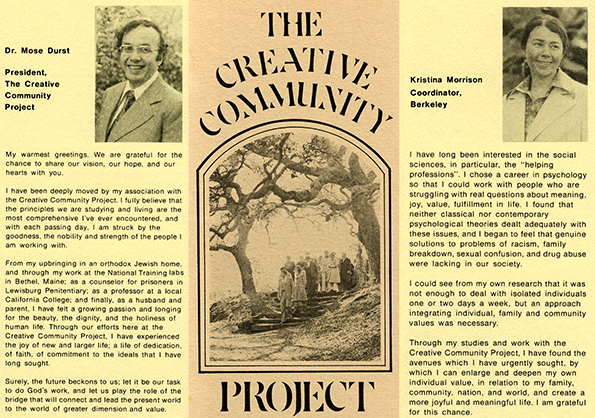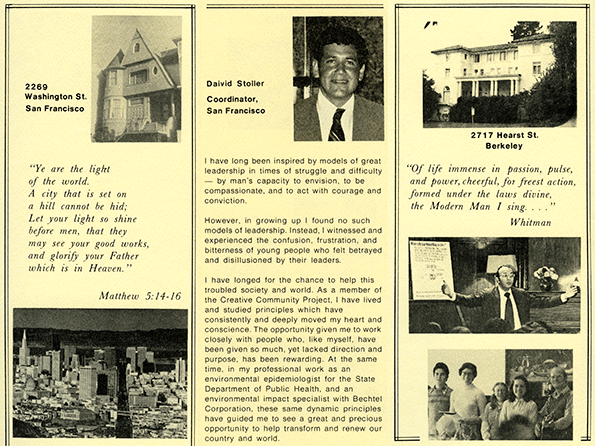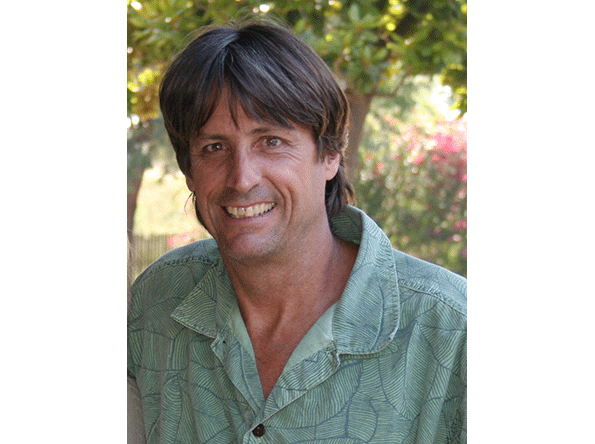
▲ Members and potential recruits at Boonville
Updated on March 10, 2023
Boonville was purchased in 1970 by Sang-Ik Choi, known as Papasan Choi. He and his wife, known as Mamasan, led the Re-Education Center which he had founded in San Francisco. Mamasan’s role in the community was significant. Yeon-Soo Lim (or Onni Durst as she was later known) ran an outpost of Papasan Choi’s community in Berkeley.
Papasan Choi’s secular teachings, The Principles of Education, were the foundation for the teaching methods used in the Bay Area and Boonville by Mose Durst, Kristina Morrison Seher and the Creative Community Project team. (see leaflet below)
About Sang-Ik Choi / Papasan Choi
Choi Sang-ik was born in 1925. At the age of two he had moved to Japan with his family, returning to Korea when they were forced to repatriate in 1945. His father gave him the name Bong-choon when he was in his twenties. He realized the significance of the name only after joining our church in April 1957 and thereafter adopted it. During his missionary days in Japan, he went by the Japanese name Masaru Nishigawa.
Mutual hostility contributed to Korea and Japan not restoring diplomatic relations until December 1965. In 1958, severe travel restrictions existed between the two countries. Talks recommenced in December that year only after Japan dropped its long-standing claim to about 80 percent of all property in Korea and its claim that Korea was the beneficiary from 1910-1945. Antiquities had been spirited away from Korea. Japan called this archeology; Korea called it theft. Any concessions on Japan’s part led to riots in Tokyo. Even in 1965, in both countries, riots and histrionic statements by politicians preceded the ratification votes.
Choi planted the seeds for the Unification Church in Japan from 1958 to 1964. Because Korea and Japan did not have diplomatic relations, he was arrested upon arrival in July 1958. Escaping confinement, he made his way to Tokyo where, after six months of struggle, he got a job as a salesman for a watch shop in the Shinjuku section. During the morning he worked. In the afternoon he witnessed. Once a week he rented the second floor of the shop to preach. On Sunday, October 2, 1959, he conducted the first Sunday service. The Unification Church of Japan commemorates this as its founding day.
Choi was married in the 36 couples under the name of Bong-Choon Choi. His wife, Mi-Shik Shin, had been expelled from Ewha Woman’s University in 1955 during the UC sex scandal. The young women did not want to testify in court. However, Moon admitted to the judge that he had lied about his age to avoid the military draft. He was sentenced to two years in jail, but was released after a few months after some “special arrangements” were made. Choi was always reluctant to talk about how his wife was “cleansed” by Sun Myung Moon.
In 1964 Choi was deported from Japan to Korea; the following year he traveled to the US where he was known as Papasan Choi. He established a community in the Bay Area, but there was conflict between his group and that of Young-oon Kim who taught the Divine Principle in a more orthodox way.
Papasan Choi died on February 23, 2023.
“Furthermore, the International Re-Education Foundation had owned some land in Boonville, California, sometimes known as [the New] Ideal City Ranch, which it turned over in a simple transfer of title in 1974 to the Unification Church.” page 111
Rev. Sun Myung Moon (1978) by Chong Sun Kim. University Press of America
In December 1974 Yeon-Soo Lim was married to Mose Durst by Sun Myung Moon in Pasadena. She became known as Onni Durst. At the same time Moon made her the Unification Church leader of California (excluding Los Angeles). In this way she inherited the Boonville property. Papasan Choi was sometimes described as a failure by leaders of the Creative Community Project, however that had not been the case.
Onni Durst had had a long and close relationship with Sang-Ik Choi / Papasan Choi.
Mose Durst:
“I later learned that Onni had joined the Unification Church in Japan in 1960. She was working at the Korean embassy in Tokyo at the time when she first met Mr. Sang-Ik Choi [in Japan he was known as Nishikawa Masaru], the first missionary sent by Reverend Moon to Japan from Korea in 1958. Onni was one of the first ten members of the Japanese Unification Church, and very soon after joining she became a pioneer missionary to the city of Shimonoseki. She had left her job at the embassy, and set out with great hope to communicate the central message of the Unification Church…
In 1965, when the Japanese church had grown significantly, Reverend Moon sent Mr. Choi and two successful missionaries from Japan to the United States. Onni was chosen along with Mr. Kenji (Daikon) Ohnuki. They thus joined the earliest missionaries from Korea in the United States: Dr. Young Oon Kim, who came in 1959; Col. Bo Hi Pak, who came in 1961, and Mr. David S. C. Kim, who also arrived in 1959.”
From To Bigotry, No Sanction by Mose Durst.
Contents of this web page:
1. Creative Community Project leaflet (extracts)
2. Michael L. Mickler: A History Of The Unification Church In America (extracts)
3. Contract for Membership in a Cultic Group or Relationship
4. David Frank Taylor: The Social Organization of Recruitment in the UC
5. Ford Greene and the Moonies
6. Links to related books and documents
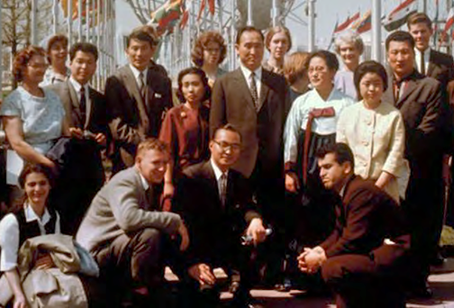
▲ Papasan Choi is standing next to Soon-wha Choi / Annie Choi who is wearing a red dress. She was the mother of Sam Park who was born in January 1966 – Sun Myung Moon (center) was Sam’s father. (photo 1969, probably at the UN Building in New York)
The Creative Community Project in its own words
Dr. Mose Durst President, The Creative Community Project
My warmest greetings. We are grateful for the chance to share our vision, our hope, and our hearts with you.
I have been deeply moved by my association with the Creative Community Project. I fully believe that the principles we are studying and living are the most comprehensive I’ve ever encountered, and with each passing day, I am struck by the goodness, the nobility and strength of the people I am working with.
From my upbringing in an orthodox Jewish home, and through my work at the National Training labs in Bethel, Maine; as a counselor for prisoners in Lewisburg Penitentiary; as a professor at a local California College; and finally, as a husband and parent, I have felt a growing passion and longing for the beauty, the dignity, and the holiness of human life. Through our efforts here at the Creative Community Project, I have experienced the joy of new and larger life; a life of dedication, of faith, of commitment to the ideals that I have long sought.
Surely, the future beckons to us; let it be our task to do God’s work, and let us play the role of the bridge that will connect and lead the present world to the world of greater dimension and value.
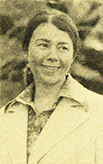
Kristina Morrison Coordinator, Berkeley
I have long been interested in the social sciences, in particular, the “helping professions’’. I chose a career in psychology so that I could work with people who are struggling with real questions about meaning, joy, value, fulfillment in life. I found that neither classical nor contemporary psychological theories dealt adequately with these issues, and I began to feel that genuine solutions to problems of racism, family breakdown, sexual confusion, and drug abuse were lacking in our society.
I could see from my own research that it was not enough to deal with isolated individuals one or two days a week, but an approach integrating individual, family and community values was necessary.
Through my studies and work with the Creative Community Project, I have found the avenues which I have urgently sought, by which I can enlarge and deepen my own individual value, in relation to my family, community, nation, and world, and create a more joyful and meaningful life. I am grateful for this chance.
Statement of Purpose
The specific and primary purposes of The Creative Community Project are:
To serve a religious, charitable and educational need in the community by providing opportunities for conscientious people to realize the ideals of service and brotherhood through the establishment of a full range of volunteer projects whereby the individual participant can express his appreciation of God, mankind, and the universe.
To provide an environment where people can actualize their individual potential and learn to establish ethical relationships with other people and with the natural environment.
To offer counseling programs designed to promote self-awareness on an individual level and ethical relationship on a collective level.
To study the causes of and to offer lectures and seminars on the breakdown of individual values and breakdown of relationship on the familial, institutional, societal and environmental levels.
To study integrated models of mental, emotional and spiritual health and to promote the development of strong individuals and families within a society as a deterrent to all forms of instability.
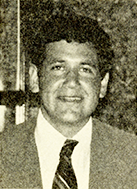
Daivid Stoller Coordinator, San Francisco
I have long been inspired by models of great leadership in times of struggle and difficulty — by man’s capacity to envision, to be compassionate, and to act with courage and conviction.
However, in growing up I found no such models of leadership. Instead, I witnessed and experienced the confusion, frustration, and bitterness of young people who felt betrayed and disillusioned by their leaders.
I have longed for the chance to help this troubled society and world. As a member of the Creative Community Project, I have lived and studied principles which have consistently and deeply moved my heart and conscience. The opportunity given me to work closely with people who, like myself, have been given so much, yet lacked direction and purpose, has been rewarding. At the same time, in my professional work as an environmental epidemiologist for the State Department of Public Health, and an environmental impact specialist with Bechtel Corporation, these same dynamic principles have guided me to see a great and precious opportunity to help transform and renew our country and world.
“Ye are the light of the world.
A city that is set on a hill cannot be hid;
Let your light so shine before men,
that they may see your good works,
and glorify your Father which is in Heaven.”
Matthew 5:14-16
Seminar
Here are the topics covered:
INTRODUCTION: Origins of skepticism, the meaning of Truth, Cause and Effect, the necessity of God, explanation of conflict and the true human way of life are all covered!
CREATION: The scientific and religious interpretations of the origin of man are synthesized, give-and-take and the way energy works, processes of growth to perfection, love and freedom, and the spiritual realm are all explained.
THE CAUSE OF CRIME: The failure of the individual to prefer the happiness of others rather than his own self-interest results in the corruption of society and individual unhappiness. Material, status, ungoverned emotion, self justification, transmission of guilt and other problems are analyzed.
THE PURPOSE OF MANKIND: Knowing the ideal and the cause of crime, we then must restore the individual and the society to its original status. A concrete plan is given that is a complete formula to accomplish this goal. The life of Jesus is given to show a constructive example of a man who tried to do this.
VISION OF THE FUTURE WORLD: All of the constructive and positive trends in man’s physical and spiritual history are projected into the future to give us a hopeful image of the future of mankind. Ideas give power and we need power to act.
THEORY OF RESPONSIBILITY: Questions on free will and/or destiny are answered in an instructive fashion to determine in what way God and man relate to accomplish the purpose of individual and collective happiness.
“There is one thing stronger than all the armies of the world: And that is an idea whose time has come… ” Victor Hugo
From a talk given by Dr. Mose Durst
Introducing the Principles
“I would like to give you a very brief introduction to the Principles that guide our foundation, Principles that allow us as individuals to realize our full value and to enter into the full value of relationship. We know that everyone wants to be happy; but how do we gain happiness? We have to establish relationship to other people and relationship to the world. So we need to know the Principles of right relationship, the means by which we can establish the unity of feeling and thought within us, the unity of feeling, thought, and action between us. …
A True Human of Life …
“We find whenever we contribute our unique value and ability for the happiness of all, centered on the conscience, we realize our individual value and our collective value—our spiritual as well as our physical fulfillment. Suppose in my attitude, in my desire, and in my action I’m working for your benefit. And in your attitude, in your desire, and in your action you are working for my benefit. All the guards, all the blocks that surround us, come down and we can come out of ourselves. But the only time we come out is when we trust the other. We have learned in management, therapy, and education that no significant learning takes place without a genuine climate of trust. That doesn’t mean just saying, “Oh, I love everybody out there!” It means with our head, our heart, and our action working for the benefit of the other person.
“So the only time we genuinely or deeply trust the other person is when we know he is working for our benefit. If we suspect that even some of the time he is not working for our benefit, then the line is clearly drawn. …
“I’m happy that I could introduce to you, in the briefest possible way, to some of the most comprehensive Principles I’ve studied or lived. I hope, then, if you’re sincere and serious about your individual as well as your collective fulfillment, your physical as well as your spiritual fulfillment, you can encounter these Principles at greater depth. Especially during our weekend seminar, where, perhaps for the first time, you can gain this sense of true relationship, true value, true fulfillment.”
Michael L. Mickler’s research is the best source on the UC in the Bay Area:
A History Of The Unification Church In America, 1959-74 – Emergence of a National Movement
Chapter 4
https://www.tparents.org/Library/Unification/Books/Huca/Huca-04.htm
“Sang-Ik Choi. While the interplay between the new church community and changes in the Bay Area environment helped produce the transformation referred to at the beginning of this section, of more import was the figure of Sang-Ik Choi. No less than Miss [Young-Oon] Kim for her group, Mr. Choi shaped the character of the local church. In this sense, the story of the Unification Church in the Bay Area during this period begins with his story. … Sang-Ik Choi was the Unification Church’s missionary to Japan from 1958 until 1964 [when he was deported].
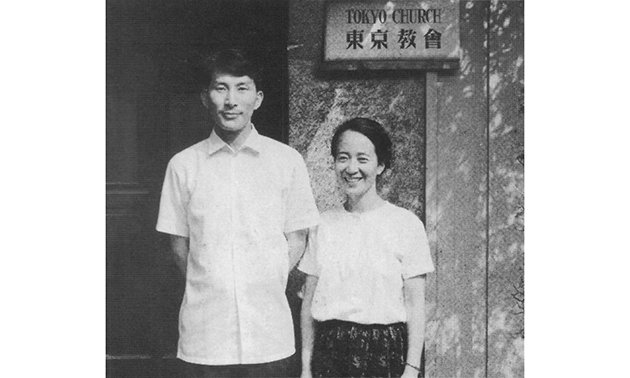
▲ Choi Sang-Ik (aka Papasan Choi) with his wife in Tokyo in the early 1960s.
The pattern of church life that emerged in Japan during that period was the result of three interrelated factors: the leadership of Mr. Choi, the national ethos of Japan, and the contingencies of the time. As it was this Japanese pattern of church life that was ‘exported’ to the Bay Area in the late 1960s, it is worthwhile to consider each of these factors individually. … When Mr. Choi arrived in the Bay Area on November 12, 1965, following Rev. Moon’s first world tour, Daikon and Soo Lim [this is Yeon-Soo Lim / Onni Durst] had already been in Washington, D.C., for several months. … Coming to the Bay Area to be with Mr. Choi, the three moved into an apartment at 43rd and Fulton St., San Francisco. … Although loyalty amid adversity, perseverance, and the all-or-nothing quality of Mr. Choi’s personal course was influential on members who consciously sought to emulate his samurai pattern, of more import for future Bay Area developments was the Japanese affinity for organization. A tight organizational structure quickly characterized the pattern of church life in Japan. This emphasis was reflected in three important developments: a communal lifestyle, a corporate church structure, and a systematic elaboration of the training session. Although aspects were modified, the Bay Area environment in the late 1960s was receptive to each of these innovations.
Whereas communal living was secondary and a pragmatic necessity among Miss Kim’s group in America, it was the basic pattern of church life in Japan from the beginning. … The cooperation and communication that facilitated living and working together was also reflected in a tighter church organization. … The organizational emphasis that characterized lifestyle and church structure in Japan was also reflected in a systematic training program. As contrasted with the more haphazard development in America, the training session in Japan achieved a significantly higher level of sophistication. Varying in length from three to forty days.”
The Principles of Education
Aside from the decision to initiate business enterprises, the other major formative influence on the new community was the publication of Mr. Choi’s Principles of Education. Unlike Miss Kim’s text which was purported to be a pure translation of the Principles as lectured in Korea, Mr. Choi’s work was a conscious adaptation. As such, it had significant impact on the direction in which the community was to move: specifically, from a theological to an educational and finally utopian focus. It is important to recognize that the Principle was the matrix of the community and was consistently taught. Nonetheless, to understand the distinctive development of the Re-Education Center, it is necessary to outline the origins, content, and implications of Mr. Choi’s Principles of Education.
The Principles of Education were written by Mr. Choi to appeal to secular, non-theistic audiences. First composed in Japan where the Christian base was slight and where the Korean origins of the Principle had to be camouflaged, the series was revised and expanded in San Francisco. Thus, the same cultural context which led the community to organize as an educational foundation also fostered a revised ideology. As for the sources of this revision, Mr. Choi’s words must suffice:
I used the Divine Principle, which is a very religious approach. But I digested the Divine Principle. Based on the Divine Principle, I put my philosophical ideas and a little bit of oriental religion together and I a little bit changed the Divine Principle.
A series of booklets published by the community during 1969, the Principles of Education elaborated specific theories of Mr. Choi: Theory of Cause and Effect, Theory of Universal Value, Theory of Good and Evil, Theory of the Ideal Man, Theory of Happiness, The Purpose of Mankind. Two titles contemplated but never written (or translated from the Japanese) were Theory of the Kaleidoscopic Community and Theory of Eternity. Basically, the series was a humanistic counterpart to the Divine Principle. Ancient wisdom was stressed over new revelation; the “human way of life” was stressed over transcendent grace; and human ignorance was emphasized over sin. In short, Mr. Choi’s Principles of Education posited the attainability of an ideal world through an application of the community’s overriding concept of conscientious common sense.
Although Mr. Choi devised a system of educational principles that would presumably lead to “divine” principles, what was critical for the community’s development was the way in which the Principles of Education assumed a life of their own. Rather than leading to theology, the Principles of Education were set off against theology. Thus, the break between the new community in the Bay Area and the one that had preceded it was complete. As Mr. Choi later remarked, “My way is more a character-educational way, and Miss Kim’s is more of a church-theological way.”
“… More than any other factor, [Mr. Choi’s] Principles of Education led the community into a utopian experiment…
Founding the International Ideal City
By the end of 1969, [Mr. Choi’s] Re-Education Center was quite successful and members could point to substantial growth. Mr. Choi’s Principles of Education were printed the previous October and, as one piece of church literature noted, over 500,000 educational pamphlets had been distributed. The International Exchange Press was turning over $24,000 worth of business a month and included sophisticated equipment as well as ten regular employees. As many as 270 San Franciscans had attended the monthly Public Meetings and the Universal Voice was circulating to 3,000 Bay Area residents. The Student Movement continued to grow and was operating on state campuses at Davis, Sacramento, Hayward, Santa Clara, and Santa Cruz. A corps of lecturers were available and the movement was also beginning to penetrate into high school classrooms. A soon to be established “adult” center would accommodate older associates. Perhaps the most accurate measure of the center’s growth was the annual financial statement of the International Unification Church. From a total income of $10,639 in May, 1968, the corporation was operating on a budget of over a quarter of a million dollars by May, 1970.
As a result of this rather phenomenal three and a half years of growth, group members found themselves at a turning point as the new decade of the 1970s began. … Mr. Choi formulated the next stage of the community’s development. At a Family Meeting on March 12, 1970, he announced:
From now on, we will increase our project to actualize the international ideal city based on our land in Calistoga. This is really good land but we will look for even more and better land . . . Later, we will expand, make our own city, our own bank and currency, our own everything. We will experiment. If we can establish the ideal city-system, we can win the whole world.
Once this declaration was made, the community quickly found “more and better land.” …
Bulletin: Our Family has just purchased 600 acres of land in Northern California, a couple of hours drive from San Francisco. Hills, streams, and beautiful farming lands are the foundations for our family’s newest project: The International Ideal City.
Located off Route 128 just south of Boonville in Mendocino County, California, the former Hiram Nobles Sheep Ranch was now the property of the Re-Education Center. While members were inspired by Edenic possibilities and tended to quote freely from the Book of Revelation, the same balance between spiritual and organizational authority that characterized the Re-Education Center also characterized the center’s approach to the International Ideal City. On the one hand, members were ‘pioneers’ exploring the new land with a spirit of high adventure. On the other hand, they were ‘scientists’ organizing a utopian experiment that would ‘prove’ their social theories. To understand the story of the International Ideal City, it is necessary to balance their pioneer spirit with the test results.
The vision of founding an ideal city, a vision which Mr. Choi articulated concretely while in Calistoga, was, in fact, the vision he had carried to the Bay Area from Japan. It had kept the community going during the early days in San Francisco, inspired the group’s entry in business enterprises, and was now leading the community into a high-risk utopian venture. Although the group was able to raise the down-payment for the land through the donation of one member, they were heavily mortgaged. On the other hand, the community felt prepared to make the leap. As Mr. Choi put it, “We must put forth great effort with a spirit of adventure.”
… the Re-Education Foundation was not to enter the promised land of utopian fulfillment.
… The next three years would bring dramatic changes to the Unification Church in the San Francisco Bay Area. The most obvious of these changes was the dismantling of all Mr. Choi had built up.
Chapter 5
https://www.tparents.org/Library/Unification/Books/Huca/Huca-05.htm
Although Mr. Choi’s Re-Education Foundation was the dominant presence of the Unification Church in the San Francisco Bay Area during the late 1960s and beginning years of the 1970s, his Re-Education Foundation (later the International Re-Education Foundation) was only one of three regional developments of the Unification Church in America. …
Again, if the anti-Communist movement served to bring Mr. Kim closer to Miss Kim’s group, it further alienated him from Mr. Choi, for whom the conflictual elements of an anti-Communist crusade simply were not appropriate. For Mr. Choi, Communism and Capitalism were both wrong, if not irrelevant. What the world needed was an international ideal city built on conscientious common sense.
On April 25, 1971, four of these couples met at Edwin Ang’s place where they “discussed the San Francisco situation in case that Mr. Choi and his wife intend to do their work independently from HQ. Seoul, Korea. . . .” 267 This suspicion was more serious than all of the charges Mr. Kim’s group had leveled at Miss Kim. Rather than his methods, Mr. Choi’s loyalty was being questioned. …
At the same time, there had been significant developments during the period. Most important were the moves beyond evangelistic witness into economic, cultural, and political activities. This full scale advance continued, though in markedly different fashion following Rev. Moon’s third world tour. That tour, begun in late November, 1971, not only inaugurated a unified American movement but also radically restructured priorities. As one of Mr. Choi’s Re-Education members wrote, “I sensed some heavy changes were coming.”
Chapter 6
https://www.tparents.org/Library/Unification/Books/Huca/Huca-06.htm
The Oakland Family
The new era launched in the Bay Area with the marriage of Soo Lim [Yeon-Soo Lim] (Onni) and Dr. Mose Durst was that of ‘The Oakland Family’. Initially a mission outpost of Mr. Choi’s San Francisco-based Re-Education Foundation, the Oakland Family’s membership totals skyrocketed from a handful of members to several hundred from 1972 to 1974.
… At the December 21, 1974 directors’ conference in Los Angeles which followed the Dursts’ wedding … Onni Durst was appointed coordinator for California, excluding Los Angeles.
… the Oakland Family’s development after 1974. By combining techniques suited to the Bay Area with the level of intensity characteristic of the national movement, the Oakland Family achieved exceptional results. At the same time, by initiating its own programs, often with a less than clear articulation of their connection to the national movement, the Oakland Family sparked tensions within.
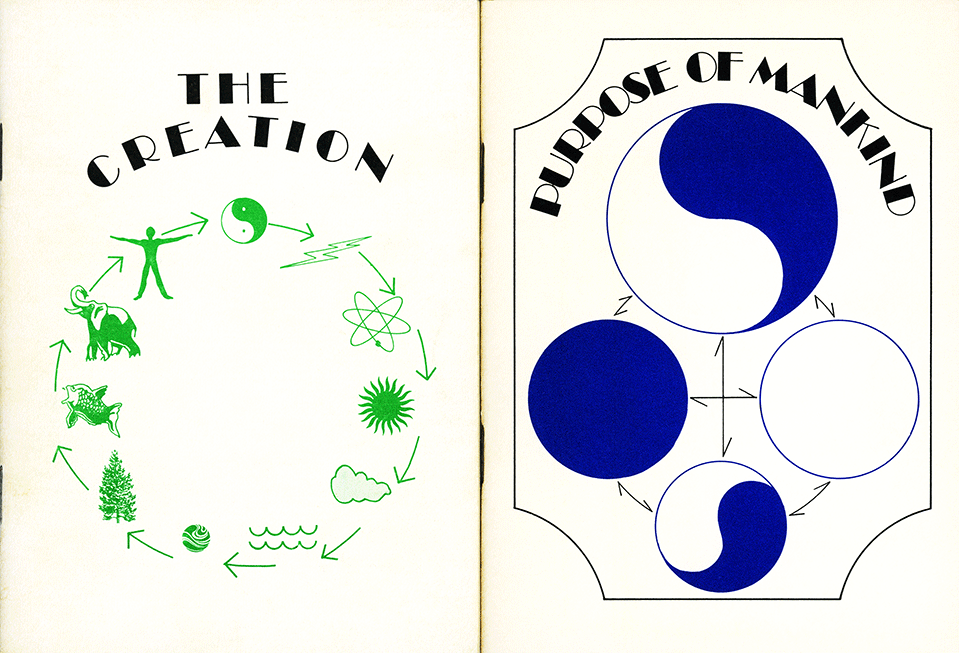 ▲ Two of a series of booklets by Mose Durst full of the “sophisticated honey of 1960’s counterculture jargon.” The back cover of each is below.
▲ Two of a series of booklets by Mose Durst full of the “sophisticated honey of 1960’s counterculture jargon.” The back cover of each is below.
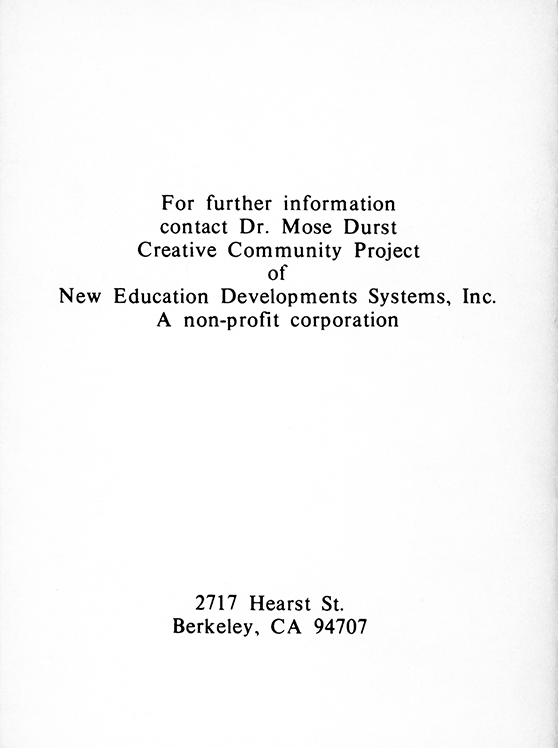 In addition, the “time bomb” to which Reverend Moon had referred, exploded after 1975 in the form of media attacks, kidnappings, deprogrammings, court cases, and government investigations.
In addition, the “time bomb” to which Reverend Moon had referred, exploded after 1975 in the form of media attacks, kidnappings, deprogrammings, court cases, and government investigations.
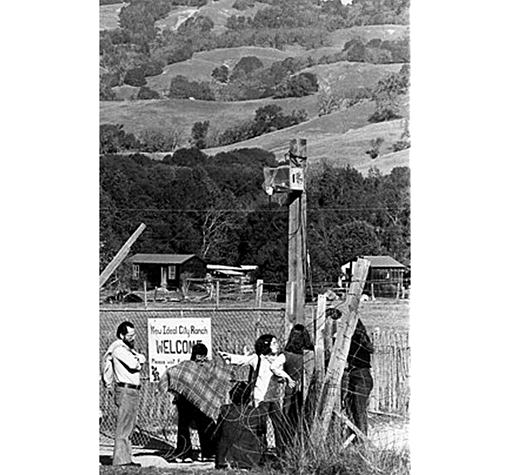
▲ The New Ideal City Ranch at Boonville
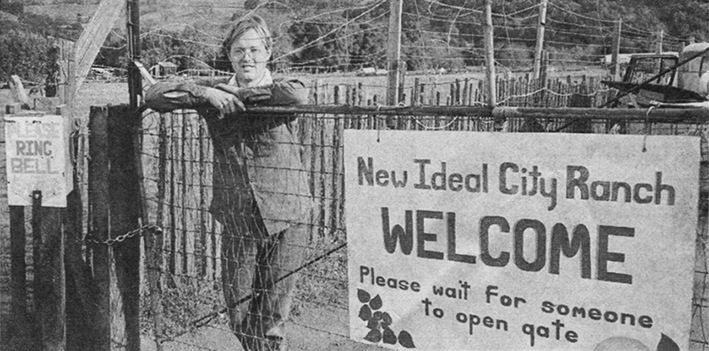
▲ The locked gate at Boonville
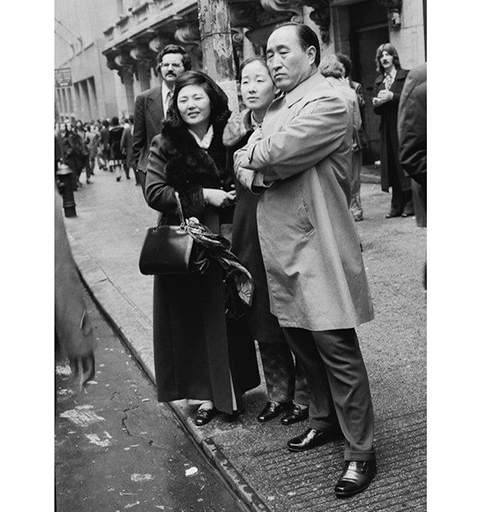
▲ Yeon-Soo Lim, Hak Ja Han and Sun Myung Moon in Manhattan c.1973
Yeon-Soo Lim / Onni Durst inherited the foundation of Papasan Choi (Sang-Ik Choi) in 1974.
Contract for Membership in a Cultic Group or Relationship
In the medical profession, ethical contracts ensure that patients have given “fully informed consent.” That is, if a doctor fails to inform a patient about the risks, side effects, and options for treatment, the uninformed patient is entitled to sue for maltreatment. Below is a mock contract for cult membership. Ask yourself if you gave informed consent at the time of your recruitment, or if you would have joined had you known your participation would involve the following conditions.
I, _______________________________ hereby agree to join
_______________________________ . I understand that my life will change in the following ways. I know what I am getting into and agree to all of the following conditions:
1. My good feelings about who I am will stem from being liked by other group members and/or my leader, and from receiving approval from the group/leader.
2. My total mental attention will focus on solving the group’s/leader’s problems and making sure that there are no conflicts.
3. My mental attention will be focused on pleasing and protecting the group/leader.
4. My self-esteem will be bolstered by solving group problems and relieving the leader’s pain.
5. My own hobbies and interests will gladly be put aside. My time will be spent however the group/leader wants.
6. My clothing and personal appearance will be dictated by the desires of the group/leader.
7. I do not need to be sure of how I feel. I will only be focused on what the group/leader feels.
8. I will ignore my own needs and wants. The needs and wants of the group/leader are all that is important.
9. The dreams I have for the future will be linked to the group/leader.
10. My fear of rejection will determine what I say or do.
11. My fear of the group’s/leader’s anger will determine what I say or do.
12. I will use giving as a way of feeling safe with the group/leader.
13. My social circle will diminish or disappear as I involve myself with the group/leader.
14. I will give up my family as I involve myself with the group/ leader.
15. The group’s/leader’s values will become my values.
16. I will cherish the group’s/leader’s opinions and ways of doing things more than my own.
17. The quality of my life will be in relation to the quality of group life, not the quality of life of the leader.
18. Everything that is right and good is due to the group’s belief, the leader, or the teachings.
19. Everything that is wrong is due to me.
20. In addition, I waive the following rights to:
• Leave the group at any time without the need to give a reason or sit through a waiting period
• Maintain contact with the outside world
• Have an education, career, and future of my choice
• Receive reasonable health care and have a say in my health care
• Have a say in my own and my family’s discipline, and to expect moderation in disciplinary methods
• Have control over my body, including choices related to sex, marriage, and procreation
• Expect honesty in dealings with authority figures in the group
• Expect honesty in any proselytizing I am expected to do
• Have any complaints heard and dealt with fairly with an impartial investigation
• Be supported and cared for in my old age in gratitude for my years of service
from pages 26 and 27 of Take Back Your Life by Janja Lalich and Madeleine Tobias (2006) ISBN 978-9720021-5-8
Unification Church / FFWPU Recruitment – The Boonville Chicken Palace
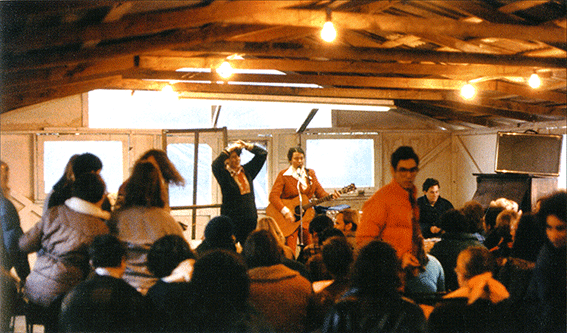
▲ The Chicken Palace at Boonville
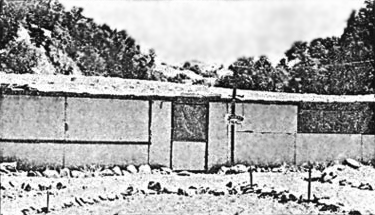
▲ The outside of the Chicken Palace
David Frank Taylor, M.A., July 1978, Sociology
The Social Organization of Recruitment in the Unification Church
(162 pages)
The purpose of this study is to provide an empirical description of recruitment into the Unification Church (now known as the Family Federation for World Peace and Unification). The Unification Church is one of many new religious movements that has appeared in America during the 1970’s. The methods Church members use to attract and secure the commitment of individuals to the Church has generated controversy in recent years.
The research was initiated under the assumption that these recruitment strategies could be understood through the use of qualitative field methods. As an ethnographic treatment of religious indoctrination, the study is based on participant observation of the recruitment process and is grounded in the interaction and language usage of participants. Close attention is given to the daily life of Church members and prospective members, where members help in a cooperative effort to persuade individuals to join their movement.
University of Montana
ScholarWorks at University of Montana
Theses, Dissertations, Professional Papers – Graduate School
http://scholarworks.umt.edu/cgi/viewcontent.cgi?article=6585&context=etd
TABLE OF CONTENTS
Abstract …………………… ii
Acknowledgements …………………… iii
Chapter I. INTRODUCTION TO THE STUDY …………………… 1
Chapter II. HISTORY, BELIEFS, AND STRUCTURE
OF THE UNIFICATION CHURCH …… 13
History and Beliefs …………………… 13
Organizational Structure …………………… 20
Controversies Surrounding the Church …………………… 23
Chapter III. A DESCRIPTION OF RECRUITMENT …………………… 31
The Encounter …………………… 31
The Elephant Bus to Boonville …………………… 36
“The Greatest Weekend” …………………… 38
The Keynote Lecture: Falling in Love, Together …………………… 40
Understanding God’s Situation …………………… 43
“A Universal Point of View” …………………… 47
“Truth and Righteousness”…………………… 50
Another Great Day …………………… 54
Sunday’s Finale …………………… 58
Chapter IV. RECRUITMENT:
A SOCIALLY ORGANIZED ACCOMPLISHMENT …………………… 62
Finding Prospective Members …………………… 62
The Choreography of Total Participation …………………… 67
Groups …………………… 71
Loving …………………… 76
Control of Communication …………………… 82
Making a Positive Evaluation …………………… 84
“We Can Be New People” …………………… 87
Lecture Reinforcement: Groups, Testimonies and Songs …………………… 90
Dreams and Destiny …………………… 92
Testimonies and Skits …………………… 94
Restoration of Value ……………………. 97
We Want to Be Those People …………………… 99
Consensual Validation …………………… 101
Expressions of Self-Fulfillment …………………… 106
Sustaining Group Unity and Brotherhood …………………… 108
Following God’s Will …………………… 112
Guiding Prospects Towards Truth and Transformation …………………… 115
Following Center …………………… 120
The True Parents …………………… 123
Idolization and Emulation of Leaders as Role Models …………………… 125
Testimonies of Transition …………………… 128
Overcoming Doubt and Negativity …………………… 131
Symbols of Commitment …………………… 135
Dramatic Commitment Scenarios …………………… 137
Accomplished Commitment …………………… 143
Chapter V. AN OVERVIEW …………………… 146
Sincere Performance …………………… 148
Trust …………………… 149
Legitimized Control …………………… 151
Enthrallment …………………… 153
Assuming the Role …………………… 155
Bibliography …………………… 160
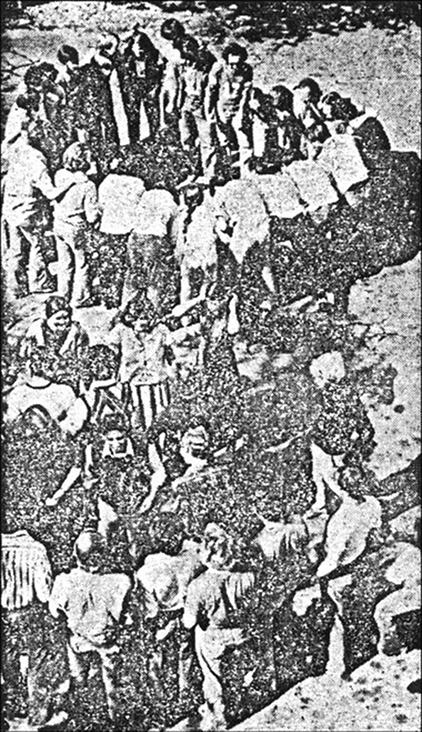 ▲ Afternoon huddle at Boonville
▲ Afternoon huddle at Boonville
Ford Greene and the Moonies
Ford Greene: Attorney at odds
By Tad Whitaker, IJ reporter January 9, 2005
Marin Independence Journal
San Anselmo resident Ford Greene sounds like a typical Marin County lawyer, what with his outspoken liberalism, scruffy hair and a white Porsche in the garage. But this self-described “cult buster” is anything but that.
Greene was in the spotlight recently for posting a large political sign on the side of his office building along Sir Francis Drake Boulevard, where commuters are faced with messages against the Iraq war and President Bush, among other things. …
But the furor surrounding the sign doesn’t compare with what’s been stirred up in Greene’s professional life: He has been prosecuted for kidnapping in Colorado and has won a landmark case before the California Supreme Court against the Unification Church that enabled former followers to sue for damages. Greene says he has de-programmed more than 100 followers —often called Moonies— of the church, which was founded in 1954 by the Rev. Sun Myung Moon.
Those professional chops made Greene one of six finalists for the honor of Trial Lawyer of Year in 2003 by the organization Trial Lawyers for Public Justice. But his drive stems from an experience many people would try to forget.
“I was a Moonie slave,” he says. “The Moonies’ nickname for me [after I became active against them] is a special servant of Satan.”
Greene’s “cult-busting” and colorful past, however, have turned him into a lightning rod for criticism for the organizations he targets.
“He’s a wing nut,” says Jeff Quiros, president of the Church of Scientology of San Francisco. “He really is.”
Aylesworth Crawford “Ford” Greene III, 52, comes from a family whose Ross Valley roots can be traced to the 1880s. …
Greene grew up the oldest of four privileged children who were raised around San Anselmo and Ross. The nuclear family expanded when two cousins needed a home after their mother died of cancer.
Greene’s father was a successful corporate lawyer who attended Yale University with former New York Sen. James L. Buckley, who became the young Greene’s godfather. His mother served as chairwoman of the Graduate Theological Union in Berkeley and was on an advisory commission for the Golden Gate National Recreation Area.
Greene … ran away [from High School] during his freshman year in 1969 and came home. “I wanted to be a hippie at Redwood with my friends,” he says.
Greene says he “terrorized” his parents while attending Redwood and ultimately graduated from Woodside Priory in Portola Valley. He briefly attended college in Southern California but left, depressed over a difficult romantic relationship.
Back in Marin, Greene bucked hay, milked cows and unclogged sewers at Straus Family Creamery before taking a backpacking trip in which he climbed 16 14,000-foot peaks in three months. At about that time, his sister Catherine, 18, disappeared.
Moonies expanding
The year was 1974 and the Rev. Moon was expanding his Unification Church in the United States. Moon, who is from South Korea, was a wealthy but controversial figure accused of brainwashing young people to support his religious organization by selling flowers among other items.
Catherine —the second youngest child and closest in nature to Greene— had joined the Unification Church and gone to a camp called New Ideal City Ranch, outside Boonville in Mendocino County. When she finally called her family, Greene says she had changed.
“It sounded like her loyalties were being split,” he says. “She sounded torn up.”
Greene traveled to the Boonville camp a few days later to confront Catherine, but it was difficult; she was surrounded by Moonies at all times. A church leader invited Greene to return the following weekend for a training session.
Greene drove home, still depressed and, he recalls, even suicidal because of a difficult relationship with his father. He decided to hear Moon speak in person at the San Francisco Opera House. Greene recalls that Moon sounded Hitler-like, “but there was a calmness afterward, and that appealed to me.”
Greene went to the training camp with two friends, but he says they were separated and escorted everywhere —including the bathroom— by at least one church member, a process he says the Moonies called love bombing. Joined by new recruits from all over the Bay Area, he attended a group session at which he explained that he’d come to rescue his sister. But then everyone turned toward him and began singing about how much they loved him.
“Holding hands and singing with 200 people felt really good to me,” he recalls. “My programming had begun.”
Greene’s friends left the camp after the weekend, but he stayed behind to listen to lectures, singing groups and discussions about personal experiences. Although images of Hitler Youth kept popping into his mind, he says church leaders poured on the love when he confronted them about the program —a strategy that helped reinforce the power structure and created self-doubt. After all, says Greene bluntly, “You’re being an a–hole to someone who’s being nice to you.”
Still unable to fully believe what he was being told —that Moon was the second coming of Christ— Greene went to a nearby creek to pray. But later that afternoon, Greene says he received an affirmation from God.
Faith begins wavering
Greene moved back to the Bay Area to live in Unification Church dorm houses in Berkeley and San Francisco, where members were expected to share toothbrushes stored in a bucket and hand over the keys to their cars. He took a job at a church-owned gas station on Market Street and, when his faith wavered, he returned to the ranch for re-education.
The re-education periods reinforced a belief that anyone against the church was Satan, he says, but it also gave him some perspective on what was happening. He remembers seeing new recruits arrive with doubts but eventually snapping under the pressure, turning their minds over to the church. It provided him with a guilty pleasure that they, too, had been unable to resist.
“That bothered me a lot,” he recalls.
It took Greene three attempts to leave the church before he was successful. In July 1975, he drove his BMW back to his parents’ house in Ross and began working with his mother, who was an outspoken critic of the Unification Church and supporter of deprogramming.
“She was a one-woman clearinghouse,” he says.
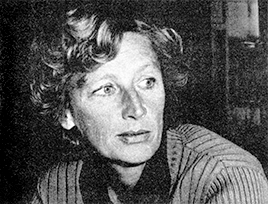
▲ Ford’s mother, Daphne Greene
Testifying before Senate
At the request of his godfather, he testified about cults at a U.S. Senate subcommittee in 1976. On that day, he says, about 50 Unification members —wearing matching blue suits with red flowers in the lapels— walked into the Senate chambers to listen.
“It was hairy,” he says.
Greene says he never worked with a deprogrammer. Using therapy, he deprogrammed himself. “It was an experience that hurt me but I was able to overcome,” he says.
Throughout his time in the Unification Church, Greene says he rarely saw Catherine. While he was working at the church-owned gas station, he says the church put her youthful good looks to work as part of a team that traveled the country raising money and bringing in new recruits.
“She could make a $1,000 a day selling flowers,” he says.
From 1976 to ’78, Greene says he deprogrammed Moonies, including the Prince of Tahiti with the cooperation of the royal family. He was even mentioned in journalist Josh Freed’s book “Moonwebs.”
One of his biggest failures, however, was an attempt to deprogram his own sister.
Greene set up a plan, using his mother as bait, to capture Catherine. Handcuffed and blindfolded, Catherine was taken by family members to a boarded-up house in Lucas Valley. But deprogramming his own sister proved harder than deprogramming strangers, with whom he could be tougher, he says.
He eventually let Catherine go after she intentionally cut her hand and had to be hospitalized. By then, Moonies were picketing his father’s law office in San Francisco and pressing the Marin County District Attorney to file kidnapping charges against the family.
No charges were ever brought against the family, but Catherine returned to the church and filed a $5.2 million lawsuit against Greene, his parents and others who helped with the abduction.
“It was horrible,” he says. “The experience is that they’re dead but you can’t put them in the ground.”
In 1977, Greene says he was hired by Colorado authorities to kidnap and deprogram a man who tried to sign over the family farm to the Unification Church. Greene worked with police officers and private investigators, but was arrested and prosecuted for kidnapping after the man ran away and returned to the church. He successfully fought the kidnapping charge because he was acting under a court order.
Off to law school
Although he never earned a bachelor’s degree, Greene was enrolled in the New College of California Law School in 1978. During that time he started getting death threats, but he was determined to go after Moon.
“This man is no different than Adolf Hitler and, as an American, I had to do something,” he says. “To play in that arena, you had to be a lawyer and I went to law school.”
After passing the California State Bar exam, Greene worked as a criminal defense attorney with San Anselmo attorney Carl Shapiro, who had developed a reputation for working with families to reclaim family members who joined cults.
With Shapiro’s help, Greene argued and won a case in 1988 before the California Supreme Court that opened the door for former Moonies to sue the Unification Church for damages and, he says, “put cult-busting on the legal map.”
In 1989, Greene says he sued the Church of Scientology on behalf of the church’s head of worldwide security and his wife. In 2002, Greene celebrated his biggest victory against Scientology, when he and two other lawyers received an $8.7 million judgment in another case.
For Greene, religious organizations must be held accountable for any socially destructive conduct that exploits the best in people. “In my book there isn’t anything worse than that,” he says. …
See also:
Ford Greene – the former Moonie became an attorney
Barbara Underwood and the Oakland Moonies
Crazy for God: The nightmare of cult life by Christopher Edwards
Mitchell was lucky – he got away from the Unification Church
Life Among the Moonies by Deanna Durham
Camp K, aka Maacama Hill, Unification Church recruitment camp
Allen Tate Wood on Sun Myung Moon and the Unification Church
Cult Indoctrination – and the Road to Recovery
The Social Organization of Recruitment in the Unification Church PDF
by David Frank Taylor, M.A., July 1978, Sociology
“Socialization techniques through which the UC members were able to influence” by Geri-Ann Galanti, Ph.D.
My Time with the Oakland Family Moonies by Peter from New Zealand
“Project Volunteer” – Moonies Infiltrate Aid-To-The-Elderly Groups, (Berkeley Barb, Oakland 1978)

